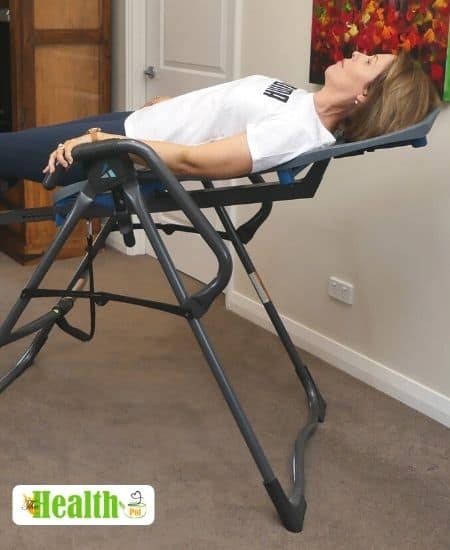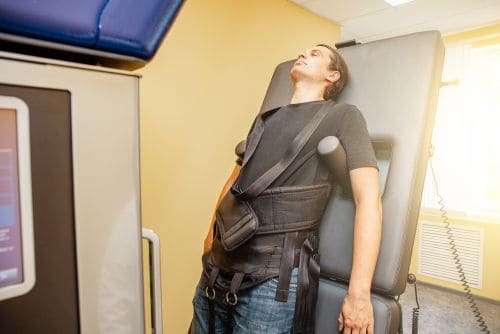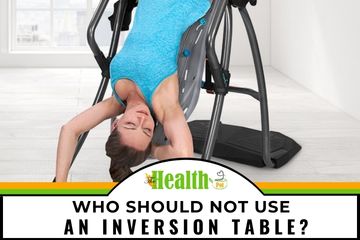Hi friends! Kathleen here again with a very important article for anyone who is thinking of buying or using an inversion table.
If you know my story, I injured my back a few years ago. It was painful, yes, but it led me to some discoveries in life, so my injury became the cloud with the silver lining, so to speak.
I was introduced to inversion tables, and I’ve never looked back!
In today’s article, I’m going to tell you all about inversion tables, what they can do, but perhaps most importantly, who should NOT use them.
Inversion tables are fine for most people, but it can pose some health risks to those who have high blood pressure, bone disorders like osteoporosis, fractures in the spine, cardiovascular problems, atrial fibrillation, cluster headaches, and glaucoma.
You’ll find the full list of these medical conditions below, including the negative side effects that hanging upside down can pose to some people. So before you use or buy an inversion table, be sure to read this blog post so you don’t risk your health.
Last, let me say that I am not a doctor or chiropractor. This should not be considered medical advice. If you have any health issues, always speak to your trusted physician or chiropractor before you use an inversion table.
Ready to turn everything upside down? Let’s go!
What Is Spinal Decompression Via Inversion Therapy or Inversion Table?
One of the many things I discovered during my rehabilitation was spinal decompression. Don’t let those big words scare you, it’s not some space-age thing that Spock uses. Spinal decompression simply means that you allow gravity to do its job by gently pulling on your spine and creating a tiny bit of space between each vertebra in your spinal column.
For some people, this small bit of space provides pain relief from neck pain, pinched nerves, or other problems. In my case, it allowed my bulging discs just enough space so that they returned to their normal position faster than they would if I had not used an inversion table.
My chiropractor actually used a machine but told me about inversion tables, and I decided to try one for myself.
An inversion table looks something like a cot that pivots so you can lie down on it and then turn yourself completely upside down. You are strapped in so don’t worry, you won’t fall out!
Using an inversion table can relieve back pain, help you pass kidney stones, and relieve pressure on the nerves, which can be helpful for conditions like sciatica.
Even after I healed, I have found that using this simple little device made me feel so much better. I’m not sure if it was also designed for stress relief, but that’s what it feels like in a way. After a long day spent typing, I love spending 10 to 15 minutes “resting” on an inversion table.
Related Post: How Long Does It Take for an Inversion Table to Work?
What Are the Dangers of Using an Inversion Table?
While an inversion table can be a great healing tool, it’s not for everyone.
Standing on your head will cause your blood pressure to rise, slow down your heartbeat, and increase the pressure inside your eyes. The same things happen when using an inversion table, which can worsen things for some people.

Therefore, you should NOT use an inversion table if you have any of the following health issues:
- High blood pressure, even if it is under control using medications
- Bone disorders such as osteoporosis, or fractures in the spine
- Glaucoma, pink eye, or inner ear infection
- Heart condition or other cardiovascular diseases
- Atrial fibrillation or AFIB
- Trigeminal neuropathy or cluster headaches
- Those who are taking blood thinners
How Long Should I Use an Inversion Table?
How long you should use the table is a matter of controversy. I usually indulge myself by staying hanging upside down for about 15 minutes, but everyone is different. Give yourself time to get accustomed to inversion therapy by starting off with only 2-5 minutes and see how you feel.
You can increase the amount of time you use inversion therapy as you wish or as your doctor recommends. FYI also read our article How many times a week should you use an inversion table?
If you have any health conditions or if you are pregnant, consult with your doctor or chiropractor before using or buying one. It is far better to be safe than sorry.
Related Info: Click Here to Read My Full Review on the Teeter Inversion Table!
Can Inversion Tables Cause a Stroke?
Whenever your body is upside down in this manner, it causes a buildup of pressure in the brain. Your heart rate will slow down but blood pressure increases, which can cause a stroke for anyone who has cardiovascular issues.

Inversion devices have been around for centuries. Most tables allow you to control just how much you wish to be inverted. Most doctors will recommend you only invert to about 30 percent, but if you are much older without issues like high blood pressure, even a 10 percent inversion will be helpful.
While I have been unable to find a single case where someone actually experienced a stroke after using an inversion table, it is a possibility.
Related Post: Are Inversion Tables Good for You?
Inversion Table Negative Side Effects
While I’m a big fan of inversion therapy, it can cause some people negative side effects. Some temporary, some not so temporary.
For one, you might experience a full retinal detachment in the eye. Other people experience painful muscle spasms or lightheadedness after they return to their normal upright position.

Others find that hanging upside down only offers very short, temporary relief from their symptoms. I’ve heard that for some, hanging upside down even for a few minutes makes their back pain symptoms worse, but I don’t believe that this is common.
For the majority of people, inversion therapy is one of the best ways to deal with low back pain, neck pain, and spinal disc compression. Regular use of inversion therapy can improve your overall spinal health and blood flow or circulatory system.
I highly recommend that you seek professional medical advice before using one if you’re unsure whether you are in good enough health to use inversion
therapy.
Related Post: Click Here to Read the Benefits of Inversion Tables!
The Final Takeaway
If you’ve really messed up your back and your doctor is suggesting surgery, you may want to try an inversion table with your doctor’s OK. Many people have been able to avoid surgery through the regular use of inversion therapy.
Everyone is looking for inversion table tips and I only have two to offer:
- Seek out a health care professional who can provide medical advice before using inverting devices
- When in an inverted position, you should take your time returning to the upright position
I once returned to the upright state and almost passed out! It’s like bending over at the waist- don’t get up too fast!
I hope you found this article helpful. Feel free to share it with your doctor, friends, or family members who might be interested in this information.
Until next time, hang tight, stay healthy, and be happy!
Written by Kathleen Langdon – TheHealthPot.com Founder
Certified Personal Trainer (CPT), Certified Corrective Exercise Specialist (CES)
Kathleen, a mother of two, struggled with ongoing weight and health issues. She created this website after she turned her life around. She built Thehealthpot.com to help inspire and motivate others with their fitness goals. Read more about Kathleen here.



